



Feature image:
Iza Pavlina, “Rule 34”, solo exhibition, Aksioma Project Space, Ljubljana, Slovenia 19 April – 12 May 2017
The Aksioma Project Space hosting Iza Pavlina’s “Rule 34“ exhibition is an immaculate visual realisation of a lifestyle minimalist’s wet dream. There are two large video projections covering the surfaces of opposite walls in the white cube. Another set of four monitors is tilted on the floor, beaming at you towards the center of the space. All projections show the same composition of a young woman, the artist herself, on a clear background, overwhelmingly beautiful and innocent, mildly disinterested, bare-shouldered, engaged in playing repetitively with a different toy in each video. The third wall is neatly adorned with a set of six C-print photos with the same flawless composition. The last wall presents outlined drawings of yet the same composition, stamped with a QRcode of pages like Pornhub, xHamster, and Xvideos. Each QRcode leads to the artist’s profile on different social media sites, where the same set of perfect videos are presented. Perhaps you have no idea what these sites are, but if you are one of a quarter of internet users who frequent online porn sites, the chances are that your own profiles on these sites are your deeply buried dirty secret.
Much like any other of your favorite social media sites, porn sites include a public profile for the gaze of all your friends and a private space for personal chats. How Web 2.0 has changed the meaning of concepts such as friends, public and private space is beside the point; What is meaningful for the exhibition is that Pavlina lets you take a sneak peek into private messages she has had with her friends, or rather fans, on these sites. For this private viewing, she adopted an exhibition format called “offline art”, which was initially developed by German artist Aram Bartholl. Essentially, every video or photo is connected to a local Wi-Fi router, which lets you hub into a specific private chat. Here is where the titillation, arousal, curiosity, surprise, even shock or disgust emerge – here, in this secret hidden space, where the boundaries of mainstream porn as we know it are challenged and explored.
Somehow, Pavlina’s interest in sexuality, pornography, and paraphilias is well summarized in the title itself. The rules of behaviour for being on the internet were posted on meme-sharing sites like 4chan.org sometime back in 2004. Rule 34 says: “There is porn of it, no exceptions.” The following two rules clarify the statement. Rule 35 says “If no porn is found of it, it will be made,” and Rule 36: “There will always be more fucked up shit than what you just saw.” [Paasonen, 2011] These three rules alone show that the diversity of pornographic exploration has exploded with the easy accessibility and seeming anonymity of online identities. Social taboos have been lost somewhere in the translation of the meaning of the virtual i.e digital. For a time, it was believed online porn had little effect on the corporeal, and the social taboo and guilt associated with it seemed not to be applicable. But it has turned out that fiddling with oneself on the internet is just as carnal. As a young artist in her 20s, Pavlina started exploring the subject a few years ago with her half-hour video piece “Talk to Strangers!” (2014). This piece was edited from online video chats, during which she pretended to be a 14-year-old girl. With this piece, she was trying to “highlight and expose in an original and unobtrusive way the global issue of disorders of sexual preference and the incidence of paedophilia on the World Wide Web”. However, in the “Rule 34” exhibition, she takes a turn from a legal and moralistic point of view towards a more uncharted and ambivalent pornographic landscape. Interestingly enough, the kink of mainstream heteronormative sexuality is a topic which really appeals to artists and researchers alike. There is a wide acceptance and interest for alternative porn in the arts, whether it is vintage, humorous or LGBT, while the mainstream is often disregarded as tacky, normative or even filthy. The first set of genres is easy to read since they obviously produce a set of meanings in the field of cultural critique. The mainstream, however, bemuses.

Now it is time to explore the toys Iza Pavlina is playing with. For her videos, she has chosen a set of less known and quite surprising paraphilias, which produce an intense sexual arousal for specific individuals. The activities may seem usual or even quite ridiculous to another individual who is turned on by something completely different. In the process of making “Rule 34”, she has uploaded the videos to her profile on various pornographic social media sites with the name of a specific paraphilia and a teasing description such as “Agalmatophilia: Virgin turns into a fuck robot”, “Balloon fetishism: Young looner babe blowing her first balloon”, “Exophilia: Nasty girl playing with balls”, “Pony play: Wild pony getting trained”, “Plushophilia: Hot naked blonde cuddling her teddy bear”, “Trichophilia: Submissive bitch gets her hair chopped off”. In these descriptions, there are a number of clichéd identifications such as blondeness, paleness, youthfulness and submissiveness, which suggests a blunt disregard for the question of race and other identities, yet she somehow evades the need for the interpretation of her actions. The videos are visceral and saturated with body and presence, yet surprisingly unintrusive. Her action is not trying to identify with the fetish nor to imitate the fantasy, but to become it. And she does so with a laboratory accuracy. The work seems to treat corporeality in Elizabeth Grosz’s terms, proposing the presence of the body without the need to reduce it to semiotic inscriptions or the assertion of meanings.
Even though the artist creates a set of online identities, she seems not to be interested in the question of mimicry or fake personalities. On the contrary, she becomes and plays with these identities, interacting with her friends or rather fans, who she teases, tempts, and attracts. She is interested in the performativity of the body, and its capability to speak for itself. As Susan Paasonen would put it, the interest lies in “resonance”, which equally “encompasses the emotional and cognitive as well as the sensory and affective” (Paasonen, 2011, 27), producing intensity, appeal, and force. “Rule 34” does not produce any metaphorical meaning, and perhaps this novelty within the storytelling of a young generation becomes most obvious if we try and compare it to an older example of paraphilia in arts. For example, we may associate the injury fetishism, which Pavlina also explores, with J.G. Ballard‘s book “Crash” and its film translation by David Cronenberg. Ballard himself explained it as a result of “the marriage of reason and nightmare, which has dominated the 20th century with its sinister technologies and the dreams that money can buy”; It is a “the merging of sex and paranoia” and “the death of affect”.

Pavlina however, finds no fear in the omnipresence of technology and the visceral connection between the human body and technological tools. She seems to value only the “resonance” of technology, regardless of what cultural conditions it is produced in. She is liberating the list of fetishes and fantasies from the history of treating sexuality in clinical terms, since the normality of desire has been culturally produced and theoretically reduced to a psychoanalytic understanding of suppressed memories, phobias and philias. There is absolutely nothing psychoanalytical about “Rule 34”. The artist goes against the understanding of paraphilias as objects of perversions. She plays and enjoys the outcome, communicates with fans and haters, and even lets the gallery visitor to sneak peek into private messages with particularly kinky content. One of these is “Cum Tribute” – the act of cumming on a printed picture, monitor or pad, which has so often been contributed to her gorgeousness, that she received in private messages for every video she uploaded. By documenting such actions, she has archived a behavioural phenomenon that is completely off the chart from conventional archives, and in her playful exploration of mainstream porn, she seems to reassure: there is nothing normative about any sexuality and that’s just fine.
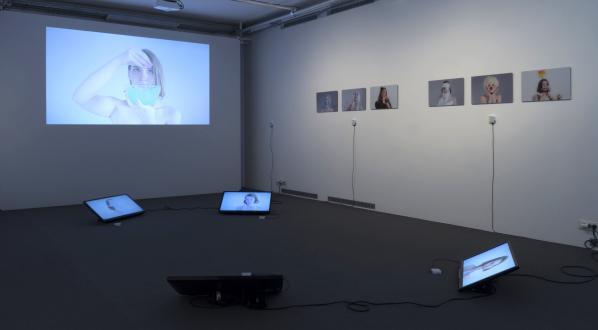
Featured Image: Charlotte Moorman with Nam June Paik, 1980. Photo © Erik Andersch
Lynn Hershman Leeson is a renowned and accomplished artist and filmmaker in her own right. Over the last three decades she has pioneered uses of new technologies in critical investigations of issues, recognised as key to the workings of our society today. She tackles the big questions surrounding: identity in a time of consumerism; privacy in a era of surveillance; the interfacing of humans and machines; the relationship between real and virtual worlds; and growing parts of the human body from DNA samples. Last year Modern Art Oxford hosted a major solo exhibition of her work Origins of a Species, Part 2 and she has work in The Electronic Superhighway, at Whitechapel Gallery, in London at the moment. Her work has had a strong influence on many contemporary artists working with technology. Recently, ZKM in cooperation with the Deichtorhallen Hamburg / Sammlung Falckenberg exhibited the first comprehensive retrospective of Leeson’s oeuvre, and also the most recent productions of her work. In May this year a book of the same name Civic Radar, will be published, featuring a comprehensive monograph of this Feminist pioneer in the fields of film and performance art, edited by Peter Weibel.
Nam June Paik was born in 1932 Seoul, Korea and died 2006. Many in the artworld regard him as a visionary artist, thinker, and innovator. Considered the “father of video art,” his groundbreaking use of video technology blurred past distinctions between science, fine art, and popular culture to create a new visual language. Paik’s interest in exploring the human condition through the lens of technology and science has created a far-reaching legacy that may be seen in broad recognition of new media art and the growing numbers of subsequent generations of artists who now use various forms of technology in their work.
Through his progressive ideas and artworks Paik dared to imagine a future where the technological and playful innovations that we now take for granted might exist. This interview with Hershman Leeson is timely, documenting the meeting of two imaginative beings who have changed the history of work at the intersection of art and technology. The issues they discuss are as important now as they were then.
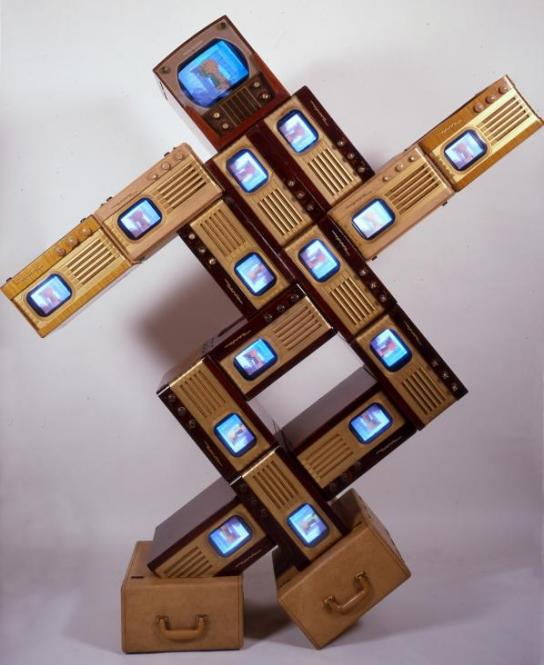
This interview of Nam June Paik by Lynn Hershman Leeson was first published by Artweek, April 1980 Electronic Art.
LHL: If you were elected president, how would you solve the world’s problems?
NJP: I just wrote an essay about how to make oil obsolete. Number one, information has to be recognized officially as an alternate energy source. Information changes our lifestyle. Dancers and yogis achieve ecstasy with 200 calories. However, racing drivers, if they want to achieve ecstasy, have to burn 200,000 calories. I found this new economical law… any consuming activities – certain activities which have a higher spiritual quality – use less energy. For instance, when rich man can buy a Jasper Johns for $100,000, that takes very little energy. However, if rich man buys Cessna airplane and flies around, it takes a lot of energy. But contributions to national economy would be the same… $100,000 spent. Same thing when you buy a videotape recorder for $500. Or if rent a car for $500 – ten days – national economy benefits from the same. But videotape recorder consumes much less energy. So when we shift our economic priorities of consuming to more spiritual sphere then we can solve all economic problems with much less energy. I found it is much easier to go to Paradise than to make this a paradise. It’s much cheaper to die than to make this world a paradise.
LHL: Do you think we’re getting closer to that now – global spirituality or global promiscuity?
NJP: Same thing. Sex requires only 800 calories. Same ecstasy, but racing cars take many more calories. Everything counts on calories. We need worldwide dieting. Lose weight.
LHL: Do you think pleasure or ecstasy is being popularly redefined because of technology?
NJP: Also because of a lack of energy. Things are getting so expensive that we have to use less. If you telephoned me instead of flying to New York, we not only save $300 air fare, we also save American Airlines gasoline. If they have less business, they will fly less. So we should move ideas and not weight. Less gravity we use the better. Transportation and communication are a trade-off. The more communication and less transportation we use, the better.
LHL: So your ideal is that we shouldn’t move too much…
NJP: Well I coined a term called “Stationary Nomad.” We are nomads but we don’t move.
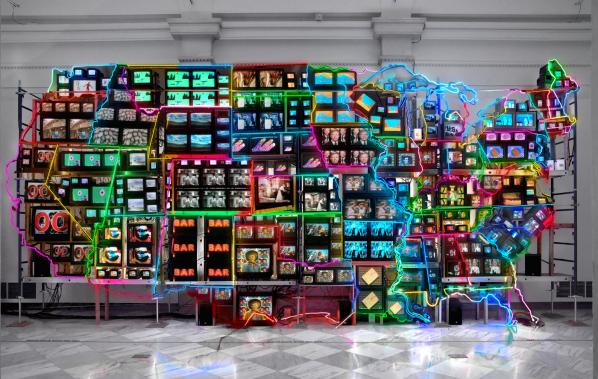
LHL: Do you think that we, as a species, are becoming biologically changed, that we’re almost becoming married to electronic systems?
NJP: Most important biological change is that when you move to moon you have to change sex patterns. You can make sex because you have certain weight. On the moon our weight is only one sixth so our whole muscular coordination has to be different.
LHL: What about all the perceptual changes?
NJP: When we have videodisc, all the New York Times microfilms will become like ten videodiscs. Then we’ll start browsing all hundred years of New York Times. Then you’ll look at early “help wanted” columns. Very interesting how the “help wanted” pattern changes over one hundred years. A new set of computer games would be born. Have you ever looked at New York Times microfilms? It’s very interesting. Celebration… that, I think, is the contribution of John Cage to world artists, because John Cage is first conceptual artist. Conceptual art is still very interesting movement because it requires least energy. No canvas. No movement. Just head!First time I’m coming from Asia to Europe, I’m flying from Calcutta to Cairo on a night plane. Everybody is sleeping. Only one light is on. A young American girl is reading paperback science fiction and I was so impressed. This girl was made for technology, you see. Celebrating.
LHL: How long will it be before ordinary people supersede movie stars, and intercommunicative TV and computers supplant fictional film?
NJP: I got an idea which I hope some capitalist will do. Interaction. Gene Youngblood had a conference at USC about the future of television, and he thought that interactive TV must be the alternative television. He knew but couldn’t quite formulate a complete idea about it. So it became chaos. Well, I thought chaos would be a great interactive TV. So the problem is how to create electronic chaos so we can enjoy each other. When you watch television or a very good film – which they make – really not very good… another one, you make it yourself, then there is also a limit of making it good because we don’t really know yet how to make our television. At the intermediate stage you will have ten different discs, and the first disc has only kissing scenes, the next only killing scenes, the third only music, the fourth only driving around scenes, the sixth just talking scenes, etc. Each disc is very complete. Kissing disc has all the kissing from movie history, every kissing of Marilyn Monroe, every kissing of Greta Garbo, and the second every killing scene from John Wayne. So we could just mix it according to our rhythms. Television proceeds in three-minute cycles. Every three minutes you want one nice thing, one bad thing, one mediocre thing… and music. So you have console and you just push buttons. So you interact with all of film history. I think that will be the intermediate stage before everyone has interactive television. It’s nice to meet and touch people, but it’s more exciting to talk very far. I just talked on telephone with Shigeko. It’s very exciting. She says: “Oh you’re never there!” She’s in a bad mood yesterday. She called… then I called back and she didn’t answer. This morning she didn’t answer again. I got an answering service. Distance makes things very exciting!
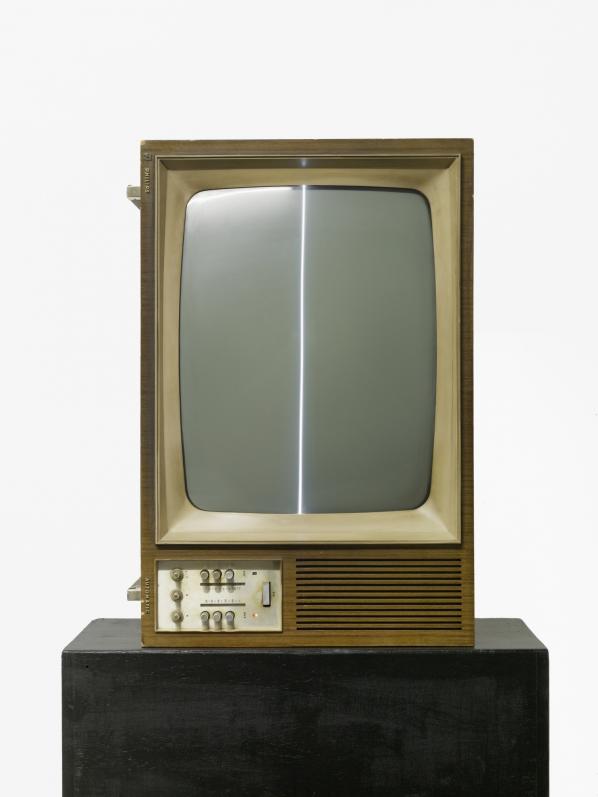
LHL: What are you working on now? You were just in Israel.
NJP: Yes. For Allen Ginsberg and Allan Kaprow. For some reason I got to know people very early in their development. I’m just lucky. I got to know Kaprow very early. These two famous men kept my friendship. They let me be their friend. So I want to make a variety show with two Allens because they are so different. Kaprow is a very cerebral man. Ginsberg is a very emotional man. Ginsberg is very semantically avant-garde and Kaprow is very formalistically avant-garde. We were going to do a show with them on a raft on the Mississippi River… let them talk to each other. This was to be me Bicentennial product. Then everything got delayed. Delay and delay and delay in our lives. That has to be solved. The plot got thicker and thicker. Two years ago I had some travel money available so I thought maybe I’d bring Ginsberg and Kaprow to Israel. Then my travel fund dried up so I had to pay for all these tickets to go to Israel. It wiped out my whole savings.
LHL: Can’t business and pleasure be the same?
NJP: Yes. But playing is more interesting. Yet playing is harder. The futurist thing is how to play without being bored. That is the most important thing… how to forget the Protestant ethic… Confucianist has same thing… how to be able to play. Americans know how to play a little bit better than Europeans or Asians. Africans know a little more about playing than Americans. America and Africa got together and made American entertainment. America invaded the world through their jazz and not by their airplanes. Because of black people’s music, America is such a big image around the world. American defenses are made form two things… hardware and software. Russians can match American hardware because they can produce. But Russians cannot match American software because Russians don’t have black people. Russian culture is all nineteenth century… Bolshio Ballet. Now you can’t make video out of Bolshoi Ballet. You can only do it live. So Bolshoi, it’s only where rich people can go who are anti-Communist anyway. So they are wasting all Bolshoi Ballet because it never reaches poor people who are target for their propaganda. That’s because their culture is made before information technology. Scott Joplin, a black man, made his art especially for mass production – the “player piano.” The black people’s music from the beginning was developed for mass production. The rich Americans packaged it to sell. Of course the black people are exploited.
LHL: Do you have trouble playing?
NJP: I think I have this guilt complex… must work all the time. My doctor told me I should get enlightened. But I always think I must get enlightened after next job. Then, with the next job, I get more and more in debt. Then I need another two jobs to pay the bills. So my enlightenment gets postponed.
LHL: Do you think being enlightened and being in debt are related?
NJP: You can act enlightened even if you are hopelessly in debt. There’s a guy I know… he’s a Catholic. He drinks. He’s very fat… but he drinks one quart of Coca Cola everyday. He thinks he’ll just work until he dies. But I don’t want that kind of enlightenment. I don’t work too hard anyway. I just work minimum.
Artweek, April 1980 Electronic Art NAM JUNE PAIK – VIDEO PHILOSOPHER
c.lynnhershman1980 all rights reserved
Choose Your Muse is a new series of interviews where Marc Garrett asks emerging and established artists, curators, techies, hacktivists, activists and theorists; practising across the fields of art, technology and social change, how and what has inspired them, personally, artistically and culturally.
Jeremy Bailey is a Toronto based Famous New Media Artist. Recent projects include performances for Rhizome’s Seven on Seven in New York, The Stedelijk Museum in Amsterdam and Tate Liverpool. Recent exhibitions include solo exhibitions at Transmediale in Berlin, and group exhibitions at Mediamatic in Amsterdam, Museums Quartier in Vienna and Balice Hertling in Paris. Recent commissions include projects for FACT in Liverpool, Turner Contemporary in Margate UK, and The New Museum in New York.
Marc Garrett: Could you tell us who has inspired you the most in your work and why?
Jeremy Bailey: Many have inspired my work but likely the most inspiring has been Canadian video performance artist Colin Campbell. He introduced me to video art and video art history as a young university student in Toronto. He made work that was funny, that lampooned the art world and somehow also made art more relevant to my young eyes. Looking back much of what I aspire to do today is directly reflective of what Colin exposed me to so early on.
MG: How have they influenced your own practice and could you share with us some examples?
JB: Absolutely, in my own work I’m often self deprecatingly self reflective of the absurd circumstances and pathos of a new media artist eking out a career against all odds.
One of my all time favourite videos by Colin Campbell is Sackville I’m Yours, in it he plays a small town art celebrity named “Art Star” who conducts a hilariously pathetic mock interview of himself.
https://www.youtube.com/watch?v=oKEzRWgih78
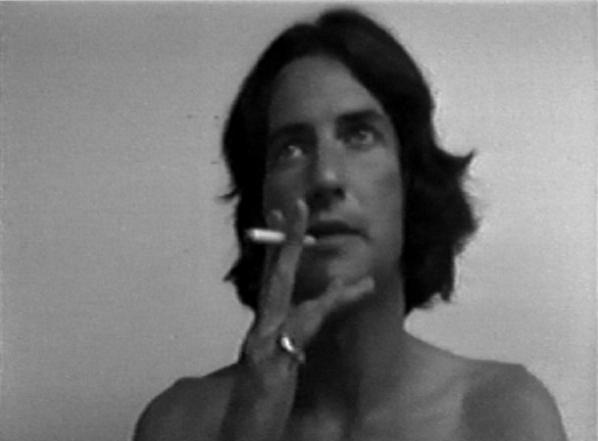
MG: How different is your work from your influences and what are the reasons for this?
JB: My video performance work differs from Colin’s because it was created as video for the Internet where his work was created in the 70s, 80s and 90s, a time where all video ended up on a TV monitor. This is an important distinction, because a lot of early video art was positioned in dialogue with the history of television. The personal narrative, the idea of a non celebrity on TV, that was a new idea. In contrast the Internet was designed from the very beginning to be accessible platform for self expression and distribution. Growing up with the Internet I can remember always feeling like anyone could be famous. No matter how niche or weird you were there was always an audience on the internet. Before I was an artist I was actually known online as a skin designer. Skins were these custom interfaces you could add to your software, usually music software, to make it your own. You can still see my skin designs from that era here http://sblcommunications.com/jbd/
MG: Is there something you’d like to change in the art world, or in fields of art, technology and social change; if so, what would it be?
JB: Yes, I’d like art to reflect positive social change instead of reflecting negative market demands. Artists have this tremendous ability and power to communicate and many are wasting that talent pandering to the decorating desires of the rich and powerful. I understand that everyone needs to make a living, but we also have a responsibility as artists to help make the world a better place. I also don’t see why these two things need to be in conflict.

Above image from The You Museum. It was “conceived of in Istanbul during a memorable residency at The Moving Museum that resulted in an exhibition you can read a review of here. The You Museum was inspired by Istanbul’s Gezi Park protests, and the ongoing debates and conflations of public and private entities and spaces in Turkey and abroad (notably by organizations such as the NSA)”
MG: Describe a real-life situation that inspired you and then describe a current idea or art work that has inspired you?
JB: Nearly all of my work is inspired by real life, I often reflect my actual circumstance in my work. My process usually involves searching for a problem and then satirically using technology to solve it poorly. In doing this I usually uncover other problems that run deeper than the initial surface issues. For example I was once invited to do a residency in an impoverished town in the Ukraine where I discovered an unpopular but bureaucratically permanent statue of Stalin in the town square. To help solve the problem of a permanent and unpopular statue I created software that allowed anyone to easily create their own wearable public sculpture that they could change anytime by screaming. This admitedly pathetic solution allowed me to navigate a number of other issues, everything from my family history to the role of art in relation to capital to the subjectivity of historical document. I’m always feeding off and reflecting the world around me. Reality is so much crazier and more interesting than anything I could invent.

MG: What’s the best piece of advice you can give to anyone thinking of starting up in the fields of art, technology and social change?
JB: This one is obvious, but hard to follow. Don’t be afraid to fail. Failing will help you learn and grow to be a better artist tomorrow. No one ever remembers your failures as well as you do – especially when your new work is good.
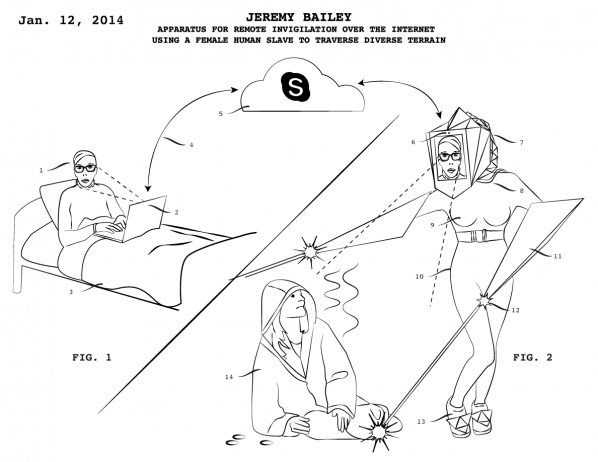
MG: Finally, could you recommend any reading materials or exhibitions past or present that you think would be great for the readers to view, and if so why?
JB: I’m reading a book today called To Save Everything Click Here by Evegeny Morozov about our culture’s obsession with technology as a go to solution for the world’s problems. Most of my work is about this very human hope that someone else has solved or will solve our problems, and many of us believe those people work in technology companies. That’s simply not true. In the book Morozov coins the term Solutionism to describe this mentality. Much of my own work could be called solutionist satire I guess, but the bottom line is we’re all capable of being a part of the solution, of making the world around us better. Ideology, good ideas, have done more to change our world for the better than any technology ever will.

Contact: info@furtherfield.org
Furtherfield Gallery is pleased to host One Minute Volume 7, a new series of shorts curated by filmmaker Kerry Baldry. The screening is accompanied by One Minute Remix, a selection of moving images from One Minute Volumes 1-5.
One Minute Volume 7 is the latest in the edition of One Minute artists’ moving image programmes curated by artist and filmmaker Kerry Baldry, and includes an eclectic mix of artists’ moving image constrained to the time limit of one minute. The One Minute programmes have been screened at numerous galleries, artists spaces and film festivals worldwide.
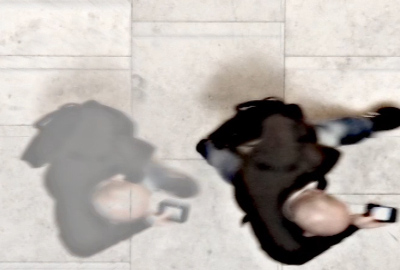
Volume 7 includes work by John Smith, Rose Butler, Tony Hill, Steven Ball, Alexander Costello, Leister/Harris, Kayla Parker and Stuart Moore, Louisa Minkin, Claire Hope, Max Hattler, Guy Sherwin, Steven Woloshen, Lynn Loo, Lumière and Son, Tansy Spinks, Gary Peploe and Peter Nutley, Eva Rudlinger, Michael Szpakowski, Zhel (Zeljko Vukicevic) , Matthias Kispert, Stuart Pound, Sellotape Cinema, Alex Pearl, My Name Is Scot, Kerry Baldry, Esther Johnson, Marty St. James, Nicki Rolls, Katherine Meynell, Chris Paul Daniels, Riccardo Iacono, Edwin Rostron, Martin Pickles, Grant Petrey, Annabel Dover, Kelvin Brown.
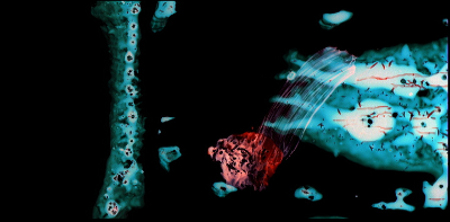
One Minute Remix (a selection from One Minute volumes 1 – 5) was originally compiled by Kerry Baldry for a screening as part of Kayla Parker and Stuart Moore’s moving image event ‘Welcome to The Treasure Dome’ (in a ICCI 360 Arena, which displayed audiovisual/moving image artwork via 5 projectors, with the screens arranged in a ‘seamless’ circle wrapped around the inside of a 21-metre diameter dome, and with surround sound) on behalf of ICCI (Innovation for the Creative and Cultural Industries) with Plymouth University; part of Maritime Mix – London 2012 Cultural Olympiad by the Sea programme, Weymouth (10 and 11 August 2012).

The programme includes work by Martin Pickles, Alex Pearl, Steven Ball, Gordon Dawson, Michael Szpakowski, Virginia Hilyard, Barry Lewis, Nick Jordan, Claire Morales, Nicki Rolls, Kerry Baldry, Riccardo Iacono, Eva Rudlinger, Zhel (Zeljko Vukicevic), Esther Johnson, Sam Renseiw and Philip Sanderson’s Lumière & Son, Katharine Meynell, Stuart Pound, Kayla Parker and Stuart Moore, Ron Diorio, Daniela Butsch, Guy Sherwin, Louisa Minkin, Rose Butler, Dave Griffiths.
+ More information: http://oneminuteartistfilms.blogspot.co.uk/
Produced by Furtherfield.
Kerry BaldryKerry Baldry is an artist/filmmaker who works in a range of media including film and video. She is a Fine Art Graduate from Middlesex University who went on to study film and video at Central St. Martins. Her first commissioned film was to make a film for BBC2’s One Minute Television which was broadcast on The Late Show – a joint collaboration between BBC2 and Arts Council England.
Over the last 6 years, aside from producing her own work, she has been curating, promoting and distributing a self initiated, unfunded project titled One Minute, One Minute Volume 7 being the latest in the edition. One Minute Volumes 1-7 are an eclectic mix of artists moving image constrained to the time limit of one minute and includes over 80 artists at varying stages of their careers.
Furtherfield Gallery
McKenzie Pavilion, Finsbury Park
London N4 2NQ
T: +44 (0)20 8802 2827
E: info@furtherfield.org
Furtherfield Gallery is supported by Haringey Council and Arts Council England.
Erica Scourti’s work addresses the mediation of personal and collective experience through language and technology in the net-worked regime of contemporary culture. Using autobiographical source material, as well as found text collected from the internet displaced into social space, her work explores communication, and particularly the mediated intimacy engendered by a digital paradigm.
The variable status and job of the artist is humorously fore-grounded in her work, assuming alternating between the role activist, ‘always-on’ freelancer, healer of social bonds and a self-obsessed documenter of quotidian experience.
Millions are blissfully unaware of the technological forces at work behind the scenes when we use social network platforms, mobile phones and search engines. The Web is bulging with information. What lies behind the content of the systems we use everyday are algorithms, designed to mine and sort through all the influx of diverse data. The byproduct of this mass online activity is described by marketing companies as data exhaust and seen as a deluge of passively produced data. All kinds of groups have vested interests in the collection and analysis of the this data quietly collected while users pursue their online activities and interests; with companies wanting to gain more insight into our web behaviours so that they can sell more products, government agencies observing attitudes around austerity cuts, and carrying out anti-terrorism surveillance.
Felix Stalder and Konrad Becker, editors of Deep Search: The Politics of Search Beyond Google,[1] ask whether our autonomies are at risk as we constantly adapt and tailor our interactions to the demands of surveillance and manipulation through social sorting. We consciously and unconsciously collide with the algorithm as it affects every field of human endeavour. Deep Search illuminates the politics and power play that surround the development and use of search engines.
But, what can we learn from other explorers and their own real-life adventures in a world where a battle of consciousness between human and machine is fought out daily?
Artist Erica Scourti spent months of her life in this hazy twilight zone. I was intrigued to know more about her strange adventure and the chronicling of a life within the ad-triggering keywords of the “free” Internet marketing economy.
Marc Garrett: In March 2012, you began the long Internet based, networked art project called Life in AdWords, in which you wrote and emailed a daily diary to your Gmail account and performed regular webcams where you read out to the video lists suggested keywords. These links as you say are “clusters of relevant ads, making visible the way we and our personal information are the product in the ‘free’ Internet economy.”
Firstly, what were the reasons behind what seems to be a very demanding project?
Erica Scourti: Simply put, I wanted to make visible in a literal and banal way how algorithms are being deployed by Google to translate our personal information – in this case, the private correspondence of email content – into consumer profiles, which advertisers pay to access. It’s pretty widespread knowledge by now that this data ends up refining the profile marketers have of us, hence being able to target us more effectively and efficiently; just as in Carlotta Schoolman and Richard Serra’s 1973 video TV Delivers People,[2] which argues that the function of TV is to deliver viewers to advertisers, we could say the same about at least parts of the internet; we are the commodities delivered to the advertisers, which keep the Web 2.0 economy ‘free’. The self as commodity is foregrounded in this project, a notion eerily echoed by the authors who coined the term ‘experience economy’, who are now promoting the idea of the transformation economy in which, as they gleefully state, “the customer is the product!”, whose essential desire is to be changed. The notion of transformation and self-betterment, and how it relates to female experience especially within our networked paradigm is something I’m really interested in.
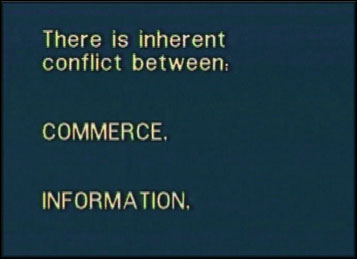
As Eli Pariser has pointed out with his notion of filter bubbles, the increasingly personalised web employs algorithms to invisibly edit what we see, so that our Google searches and Facebook news feeds reflect back what we are already interested in, creating a kind of solipsistic feedback loop. Life in AdWords plays on this solipsism, since it’s based on me talking to myself (writing a diary), then emailing it to myself and then repeating to the mirror-like webcam a Gmail version of me. This mirror-fascination also implies a highly narcissistic aspect, which echoes the preoccupation with self-performance that the social media stage seems to engender; but narcissism is also one of the accusations often leveled at women’s mediated self-presentation in particular, despite, as Sarah Gram notes in a great piece on the selfie, [3] it being nothing less than what capital requires of them.
![Girl with a Pearl Earring and a Silver Camera. Digital mashup after Johannes Vermeer, attributed to Mitchell Grafton. c.2012. [4]](http://www.furtherfield.org/wp-content/uploads/2013/05/vermeer_selfie.jpg)
And as this project is a form of autobiography and diary-writing, it could also be seen as both narcissistic and as asserting the importance of personal experience and emotions in the construction of a humanist, unified subject. Instead, I wanted to experiment with a way of writing a life story that operated somewhere between software and self, so that, as Donna Harraway says “it is not clear who makes and who is made in the relation between human and machine”. Part of the humour of the project arises from the dissonance between the staged realism of the webcam (and my real cat/ hangover/ bad hair) with the syntactically awkward, machinic language, which undermines any notion that this diary is the expression of any authentic subject.
The demanding aspect of it is something I was interested in too, since it calls up the notion of endurance as a virtue, and therefore as a value-enhancer, which many artworks – from mind-boggingly labour intensive supercut-style videos to sculptures made from millions of pins (or whatever) – trade on. You just can’t help but ask ‘wow…how long did that take?!’ – as if the time, labour and effort, i.e. the endurance, necessarily confer value. So there is a parallel between a certain kind of ‘age of austerity’ rhetoric that valorises resilience and endurance and artworks that trade on a similar kind of doggedness – like Life in AdWords does.
And finally – it made me laugh. Some of the text was so dumb, and funny, it amused me to think of these algorithms dutifully labouring away to come up with key-phrases like ‘Yo Mamma jokes’ and ‘weird pants’.
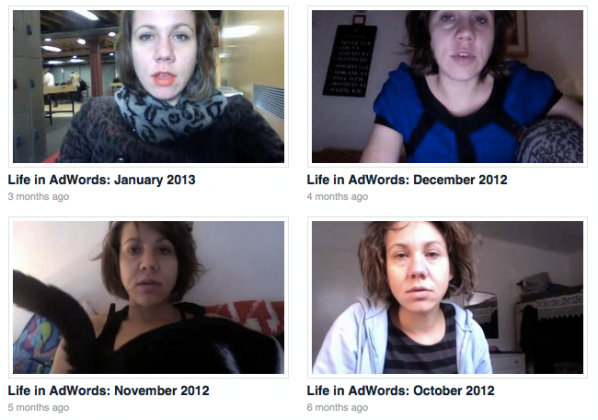
MG: It ran until 20th January 2013, and ended due to system changes in the Gmail ad settings. How many videos did you produce and were you glad when it all had finally ended?
ES: Not sure how many I made – but I was 6 weeks short of the intended year, so definitely over 300. Actually I was infuriated and somewhat depressed when it ended without warning and in a moment of panic I even thought about somehow cheating it out to the end; but working with a system that is beyond your control (i.e. Google) necessarily involves handing over some of your authorial agency. So instead I embraced the unexpected ending and threw a kind of send-off party plus performance in my bedroom/ studio to mark it.
But this question of agency is obviously crucial in the discussion of technology and runs through the project in various ways, beyond its unintended termination. At the level of the overall structure, it involves following a simple instruction (to write and process the diaries every day and do the webcam recording) which could be seen as the enactment of a procedure that echoes the operation of a software program carrying out automated scripts. And on the level of the texts, while all the language used in the project was generated and created by the software, I also was exercising a certain amount of control over which sections of the diary I favoured and editing the resulting lists, a move which seemingly reasserts my own authorial agency.
Thus the texts are more composed and manipulated than they first appear, but of course the viewer has no way of knowing what was edited out and why; they have to take it on faith that the texts they hear are the ‘real’ ones for that diary.
MG: During this period you recorded daily interactions of the ongoing experience onto webcam. As you went through the process of viewing the constant Google algorithms, I am wondering what kind of effect it had on your state of mind as you directly experienced thousands of different brands being promoted whilst handing over the content once again, verbally to the live camera?
ES: I’m not sure what effect it had on my state of mind, though considering the amount of concerned friends that got in touch after viewing the videos, Google certainly thought I was mostly stressed, anxious and depressed. Maybe it’s just easier to market things to a negative mind state.
But also, the recurrence of these terms was no coincidence; early film theorist Tom Gunning has argued that Charlie Chaplin’s bodily movement in Modern Times [5] ‘makes it clear that the modern body is one subject to nervous breakdown when the efficiency demanded of it fails,’ and compares his jerky, mechanical gestures with the machines of his era.
So I was interested in if and how you could do something similar for the contemporary body; how can we envisage it and its efficiency failures in relation to the technology of today when our machines are opaque and unreadable, if we can see them at all. Maybe what they ‘look like’ is code (a type of language), so it would entail some kind of breakdown communicated through language rather than bodily gestures – though the deadpan delivery certainly evokes a machinic ‘computer says no’ type of affectlessness.
Also, Franco Berardi has spoken of the super-speedy fatigued denizen of today’s infoworld, for whom “acceleration is the beginning of panic and panic is the beginning of depression”. In a sense this recurrent theme of stress and anxiety disavows the idea of the efficient, ever-ready, always-on subject of neo-liberalism – and yet the project as a whole kind of sneakily joins the club too, since it obeys the imperative of productivity by turning a diary (personal life, non-work) into a ‘project’ (i.e. work).
As mentioned earlier in terms of the ‘transformation economy’, I’m really interested in this idea of efficiency also as it manifests in rhetorics of self-betterment, and its relation to the neo-liberal promotion of self-responsibility (if you’re poor, it’s your fault….). Diaries and journal writing – as well as meditation, yoga, therapy, self-help etc – are often championed in everything from cognitive fitness to management literature as excellent ways of becoming more ‘efficient’. The underlying belief seems to be that by unloading all the crap that weighs you down, from emotional blockages to unhelpful romantic attachments to an overly-busy mind, you’d get an ‘optimised you’. Why this is necessarily a good thing – apart from the elusive promise of ‘happiness’ of course – is never really discussed.
Tiqquun’s notion of the Young Girl, the model consumer-citizen, is interesting in this regard – taking good care of oneself reframed as a form of subservience which maintains the value and usefulness of our bodies and minds to capital. Their idea that the Young Girl (not actually a gendered concept in their estimation) “advances like a living engine, directed by, and directing herself toward the Spectacle” also points to the irony beneath what appears to be a very humanist/ individualist inflection to these discourses of self-realisation: they could also be read as a latent desire to become somehow more ‘machine-like’, as if we could therapise/ meditate/ journal/ jog away our mind-junk with the swiftness and ease of emptying the computer’s trash, thereby becoming more productive.
And yet I’m clearly complicit in this, as I write diaries, meditate, do yoga and obsess over my bad time management, as Life in AdWords makes clear both in the recurrence of all these activities in the texts and obviously in its structure as a daily journal project.
MG: Robert Jackson in his article Algorithms and Control discusses in his conclusion that even though “use of dominant representations to control and exploit the energies of a population is, of course, nothing new”, when masses of people respond and say yes to this “particular reduced/reductive version of reality”, as an act of investment it “is the first step in a loss of autonomy and an abdication of what I would posit is a human obligation to retain a higher degree of idiosyncratic self-developed world-view.” Alex Galloway also explores this issue in his book Protocol: How Control Exists after Decentralization, where he argues that the Internet is riddled with controls and that what Foucault termed as “political technologies” as well as his concepts around biopower and biopolitics are significant.
Life in AdWords, seems to express the above contexts with a personal approach on the matter. Drawing upon an artistic narrative as the audience views your gradual decline into boredom and feelings of banality. The viewer can relate to these conditions and perhaps ask themselves similar questions as they go through the similar experiences. Thus, through performance and a play on personal sacrifice on a human level, it elucidates the frustrations on the constant, noise and domination of these protocols and algorithms and how they may effect our behaviours.
With this in mind, what have you learnt from your own experience, and how do you see others regaining some form of conscious independence from this state of sublimation?
ES: I found Galloways’ explanation of Foucault’s notions of biopower to be some of the most interesting parts of that book – as he puts it “demographics and user statistics are more important than real names and real identities”, so it’s not ‘you’ according to your Amazon purchase history, but more ‘you’ according to Amazon’s ‘suggestions’ (often scarily accurate in my experience). Which is where the algorithms come in; they do the number-crunching to be able to predict what you might buy, and hence who you are, not because anyone cares about you particularly, but because where you fit in a demographic (a person who is interested in art, technology, etc..) is useful information and creates new possibilities for control.
Regaining conscious independence… hmm. I found it interesting that during the project, the people I explained it to would often report back to me on what keywords their emails had produced, and what adverts came up on Facebook, as they hadn’t really noticed before – so perhaps in these cases it made people more conscious of the exchange taking place in the ‘free’ web economy. Others took up AdBlocker in response, which is one way of gaining distance – by opting out. However, the info each of us generates is still useful, since even if you aren’t seeing the ads, your choices and interactions are still being parsed and thus help delineate a particular user group of citizen-consumers.
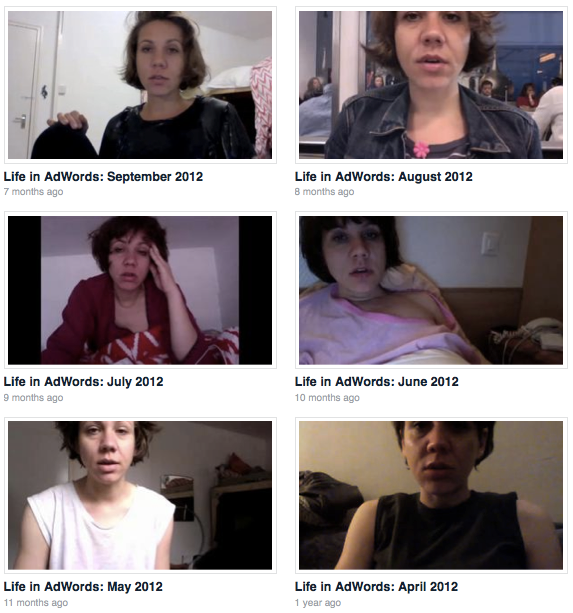
Despite this, my feeling is that opting out – if it’s even possible – can be a way of pretending none of this stuff is happening. I’m generally more interested in finding ways of working with the logic of the system, in this case the use of algorithms to sell things back to us, and making it overly obvious or visible. Geert Lovink asked whether its possible for artists to adopt an “amoral position and see control as an environment one can navigate through instead of merely condemn it as a tool in the hands of authorities” and his suggestion of using Google to do the ‘work’ of dissemination for you, in spreading your meme/ word/ image, is one I’ve thought about, particularly in other works (especially Woman Nature Alone). This approach entails hijacking the process by which Google’s algorithms organise the hierarchy of visibility to one’s own ends – a ‘natural language’ hack, as Lovink puts it.
In contrast, Life in AdWords makes visible the working of the algorithmic system more on the level of the language it produces. It also employs humour, and laughter has been one of the main responses people have had when watching the videos, for a number of reasons. The frequent dumbness of the language and/ or the juxtapositions (‘Where is God?’, ‘Eating Disorder Program’); the flattening out of all difference between objects/ feelings/ places (e.g. work-related stress, cat food, God, Krakow); and the lack of shame the software exhibits in enumerating bodily and mental malfunctions (blood in poop, wet bed, fear of vomiting) are all quite amusing in and of themselves.
That shameless aspect also echoes the over-sharing and ‘too much information’ tendencies the web (especially social media) seems to encourage, which Rob Horning has written about in his excellent blog, Marginal Utility. It also foregrounds that whatever the algorithms can do, what they still can’t do is emulate the codes of behaviour governing human interaction – including knowing when to shut up about your ‘issues’.
The frequent allusions to these bodily and mental blockages also point to the limits of the productivity imperative – a refusal to perform enacted through minor breakdowns – while bringing it back to an embodied subject, who despite her immersion in networked space is still a body with messy, inefficient feelings, needs and urges. And the comically limited portrait the keywords paint maybe suggests that despite the best efforts of Web 2.0 companies, we still are not quite reducible to a list of consumer preferences and lifestyles.
MG: What are you up to at the monment?
ES: Amongst other things I’m doing a residency with Field Broadcast (artists Rebecca Birch and Rob Smith) called Domestic Pursuits, a project which ‘considers the domestic contexts of broadcast reception and the infrastructure that enables its transmission.’
And I’m working on some drawings plus a video involving Skype meditation with members of the Insight Timer meditation app community, for A Small Hiccup, curated by George Vasey and opening 24th May at Grand Union, Birmingham- the video is being shown online tommorrow.
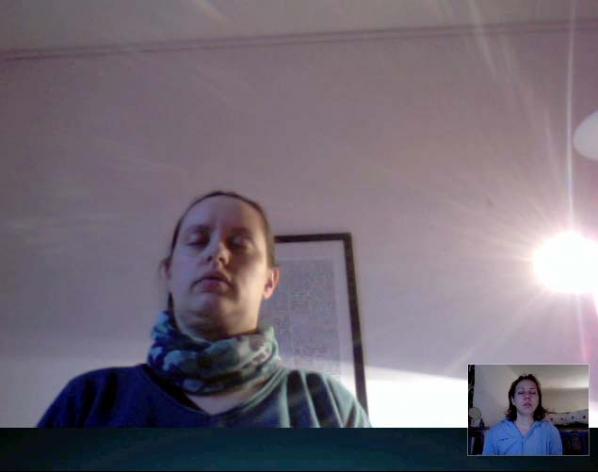
Also I’m attempting and mostly failing at the moment to write my dissertation for the MRes in Moving Image Art I’m doing at Central St Martins and LUX.
Personal Web searching in the age of semantic capitalism: Diagnosing the mechanisms of personalisation. Martin Feuz, Matthew Fuller, and Felix Stalder.
http://firstmonday.org/article/view/3344/2766
Live Performance. KONRAD BECKER (aka Monoton) featuring SELA 3 themes from “OPERATIONS” (15 min.). Published on Jul 9, 2012. YouTube.
http://www.youtube.com/watch?v=HMscYTAF4wY
Erica Scourti was born in Athens, Greece in 1980 and now lives in London. After a year studying Chemistry at UCL, an art and fashion foundation and a year of Fine Art Textiles at Goldsmiths, she completed her BA in Fine Art at Middlesex University in 2003 and is currently enrolled on a Research degree (Masters) in Moving Image Art at Central Saint Martin’s College of Art & Design, run in conjunction with LUX. Her area of research is the figure of the female fool in performative video works.
She works with video, drawing and text, and her work has been screened internationally at museums like the Museo Reine Sofia, Kunstmuseum Bonn and Jeu de Paume Museum, as well as festivals such as the Recontres Internationales, interfilm Berlin, ZEBRA Film Festival, Antimatter, Impakt, MediaArt Friesland, 700IS as well as extensively in the UK, where she won Best Video at Radical Reels Film Competition; recent screenings include Video Salon Art Prize, Exeter Phoenix, Bureau Gallery, Tyneside Cinema and Sheffield Fringe Festival.
Her work has also been published in anthologies of moving image work like Best of Purescreen (vols 1, 2 and 3) and The Centre of Attention Biannual magazine.
more info – http://www.ericascourti.com/art_pages/biography.html
DoggieWoggiez! PoochieWoochiez! is a new video work (2012) by Everything is Terrible!, a self-described “found footage chop shoppe”. DoggieWoggiez! PoochieWoochiez! is an active catalog which describes, invents and destroys concepts as it arranges video footage into flows of multiple cuts that map the use of dogs in cinema and television. The structure of this review takes hints from the work it overlays. We dispensed with “original” writing and didactic detailing of what we as critics experienced. Instead, we unraveled multiple threads left hanging after watching DoggieWoggiez! PoochieWoochiez! We neglected to offer an appraisal of the worth of the work, and add to the number of words already in the world. Instead, we traced the flows passing through the video and developed a program of citations that provide a map of exit and entrance points-a map, as any map, that is as much about those making as about the territory described-which we hope will provide openings for a reader who has not yet watched the work, and provide expanded intersections for those who already have.
“This is the scenario: You are terminally ill, all medical treatments acceptable to you have been exhausted, and the suffering in its different forms is unbearable. Because the illness is serious, you recognize that your life is drawing to a close. Euthanasia comes to mind as a way of release.” 1
“Success consists of simply getting up one more time than you fall.” 2
“From whatever angle you approach it, the present offers no way out. This is not the least of its virtues. From those who seek hope above all, it tears away every firm ground. Those who claim to have solutions are contradicted almost immediately. Everyone agrees that things can only get worse. ” 3
“A positive anything is better than a negative nothing.” 4
“I think it’s because dog movies and dog footage tends to be the dumbest. It’s like the lowest common denominator amongst everything we’ve found, the most mediocre footage imaginable. I think that was a big motivator, and we just like dogs. It’s a nicer way to deliver horrible things about humanity. Instead of watching people be racist, which makes you feel terrible, you get to watch dogs be racist, and you’re like, ‘That’s a little better.'” 5
“Americans spent $50.96 billion on their pets in 2011. That’s an all-time high, and for the first time in history more than $50 billion has gone to dogs, cats, canaries, guppies and the like, the American Pet Products Association reports. Food and vet costs accounted for about 65 percent of the spending. But it was a service category one that includes grooming, boarding, pet hotels, pet-sitting and day care that grew more than any other, surging 7.9 percent from $3.51 billion in 2010 to $3.79 billion in 2011.” 6
“So we have a corpse on our backs, but we won’t be able to rid ourselves of it just like that. Nothing is to be expected from the end of civilization, from its clinical death. In and of itself, it can only be of interest to historians. It’s a fact, and it must be translated into a decision. Facts can be conjured away, but decision is political. To decide on the death of civilization, then to work out how it will happen: only decision will rid us of the corpse.” 7
2:39 . Black and white footage of a clothed dog sleeping in hay.
2:41 . Saint Bernard laying on the floor trying to drink champagne out of a bottle.
2:42 . Black and white footage of a dog holding a bottle labeled “Hard Cider” in his mouth and drinking.
2:43 . Dog with bandana sitting at table licking the foam from a beer.
A hand pouring beer into a dish filled with dog food.
2:44 . A club. Multiple young women filling the face of a puppet dog full of liquor bottles.
2:45 . A dog wearing a jersey with the number one peeing on a referee’s ankle.
2:47 . A dog lifting its leg on a pants suit leg.
A bulldog in a spiked collar peeing on a floor mat that says “I [heart] Acting.”
2:48 . A dog peeing on a metal catwalk, shot from below.
2:49 . Jack Nicholson holds a small dog up and away from his chest as the dog pees.
A man lying on a floor is shot below and through a dogs legs, the dog’s urine stream is hitting him in the face.
2:51 . A similar shot, reversed. Another man, wearing a fur hat, is buried to his neck in sand and ice. A dog urinates into his mouth.
2:51 . The same bulldog in spiked collar lifts his leg to pee. A small rocket comes out of from beneath him.
2:52 . A similar shot from the other side, a different dog is urinating flames.
“I am for an art that embroils itself with the everyday crap & still comes out on top.” 8
“Trash collection is the business of public sanitation; its recycling, the very height of capitalist alchemy, turns everything into grist for commodification’s mill. But it is also a strategy of aesthetic sublimation that, according to Thomas Crow, is internal to modernism (he has analyzed the cyclical aspect of this in terms of the incorporation of the ‘low’ by the ‘high’)” 9
“Classification in the widest sense is, along with astronomy, probably one of the oldest scientific pursuits undertaken by man. In the most general terms classification is the process of giving names to a collection of objects which are thought to be similar to each other in some respect. The ability to sort similar things into categories is obviously a primitive one, since it would seem to be a prerequisite of the development of language, which consists of words which help us to recognize and discuss the diSerent types of events, objects and people we encounter; each noun in a language is a label used to describe a class of things which have striking features in common. Thus for example, we name animals as cats, dogs, or horses and such a name collects individuals into groups.” 10
“I am for an art that imitates the human, that is comic, if necessary, or violent, or whatever is.” 11
“What is it that moves over the body of a society? It is always flows, and a person is always a cutting off [coupure] of a flow. A person is always a point of departure for the production of a flow, a point of destination for the reception of a flow, a flow of any kind; or, better yet, an interception of many flows.” 12
“I am for the art of things lost or thrown away, coming home from school.” 13
“Cluster analysis, also called data segmentation, has a variety of goals. All relate to grouping or segmenting a collection of objects into subsets or “clusters,” such that those within each cluster are more closely related to one another than objects assigned to different clusters. An object can be described by a set of measurements, or by its relation to other objects.” 14
“And now, we have to start from scratch with this movie and go through thousands of VHS tapes and find those three minutes and put them in a pile until we have enough to make an hour-long movie. And yeah, it made it harder because we just fucking hate those movies.” 15
“Central to all of the goals of cluster analysis is the notion of the degree of similarity (or dissimilarity) between the individual objects being clustered. A clustering method attempts to group the objects based on the definition of similarity supplied to it.” 16
“[Claes Oldenburg] quickly saw that it didn’t take anything to make a Ray Gun: any right angle would suffice, even blunted, even barely perceptible. The Ray Gun is the ‘universal angle’: ‘Examples: Legs, Sevens, Pistols, Arms, Phalli-simple Ray Guns. Double Ray Guns: Cross, Airplanes. Absurd Ray Guns: Ice Cream Sodas. Complex Ray Guns: Chairs, Beds. Mondrian didn’t need to reduce everything to the right angle: everything is already a right angle. During the time of The Store, Oldenburg made huge numbers of Ray Guns (in plaster, in papier mache, in all kinds of materials in fact), but he soon saw that he didn’t even need to make them: the world is full of Ray Guns. All one has to do is stoop to gather them from the sidewalks (the Ray Gun is an essentially urban piece of trash: Oldenburg produced their anagram as Nug Yar:New York). Even better: he didn’t even need to collect them himself; he could ask his friends to bring them to him (he limited himself to accepting or refusing the find’s addition into the corpus, according to purely subjective criteria). Finally, there are all the Ray Guns one can’t move- splotches on the ground, holes in the wall, torn posters-but which one could photograph. The “inventory”is potentially infinite. And what should be done with this invasive tide? Put it in the museum.” 17
“I am for the art out of a doggy’s mouth, falling five stories from the roof.” 18
2:54 . A dog and man lay side-by-side. The dog’s legs are up and its belly is exposed to the camera. Voiceover: “Being a thief isn’t bad enough, you have to be a lush too.”
2:56 . A golden retriever puppy faces the camera with a drunken expression. The dogs lips move as he says “That’s the weirdestest grape juice ever.” He laughs.
3:02 . A dog jumps off a large desert rock onto another rock. He yells “Hasta la vista, kitty.” A mountain lion is shown launching into the air.
3:05 . Maniacal laughter is played over footage of a tree frog sitting on the top of a dog’s head.
3:06 . A Weimaraner sleeps under a blanket. Voiceover: “Do dogs dream? She dreams she’s a dear”
A ripple dissolve into the same dog with her head stuck through a tapestry of deer so that it appears that there is a deer with a dog head.
“Are there Oedipal animals with which one can ‘play Oedipus,’ play family, my little dog, my little cat, and then other animals by contrast draw us into an irresistible becoming? Or another hypothesis : Can the same animal taken up by two opposing functions and movements, depending on the case?” 19
“Writing about the dog who befriended him and his fellow-inmates in a concentration camp, and whom they named Bobby, Levinas says that this dog was ‘the last Kantian in Nazi Germany,’ because his joyful greetings reminded the prisoners of their human dignity. Yet, when questioned closely about the ethical status of nonhuman animals, Levinas is reluctant to ascribe to animals that ‘ethical face’ which he elsewhere has called (as Martin calls Sylvia’s face) ‘an epiphany.’ By contrast, says Levinas, the animal face is merely ‘biological,’ incapable of demanding the ethical response. Levinas denies that the dog can have a face in the ethical sense: ‘the phenomenon of the face is not in its purest form in the dog,’ he writes. ‘I cannot say at what moment you have the right to be called ‘face.’ The human face is completely different and only afterwards do we discover the face of the animal.’ In an article subtitled ‘Levinas Faces the Animal,’ Peter Steeves, with gentle irony, stages another face-to-face encounter between Levinas and Bobby, asking the philosopher: ‘What could Bobby be missing? Is his snout too pointy to constitute a face? Is his nose too wet? Do his ears hang low, do they wobble to and fro? How can this not be a face?'” 20
“We’ve always had a thing with how people treat little people at Everything Is Terrible!, like it’s really weird and creepy. Anybody who’s like a second-class being, when they’re used in videos, it comes across very creepy and gross. I think it’s the same thing with humans and dogs. They’re weirdly sexualized, they’re weirdly turned into little kids at the same time.” 21
“…individuated animals, family pets, sentimental, Oedipal animals each with its own petty history, ‘my’ cat, ‘my’ dog. These animals invite us to regress, draw us into a narcissistic contemplation, and they are the only kind of animal psychoanalysis understands, the better to discover a daddy, a mommy, a little brother behind them (when psychoanalysis talks about animals, animals learn to laugh): anyone who likes cats or dogs is a fool.” 22
“I think that’s a big reason why people use dogs the way they do, because I think we kind of hate ourselves so we dress up dogs like ourselves to mock ourselves. So you dress a dog up like a drunk human, and then you laugh at how ridiculous it is, but I think it’s therapeutic. We’re letting off steam about how much we hate ourselves.” 23
3:13 . A close-up of a shaggy dog who speaks. “It’s not a dream”.
3:16 . A large dog outside a car tells a small dog inside a car, “Bitches ain’t got no business being inside your head” The voice is or is similar to Samuel Jackson’s.
3:17 . A bloodhound with an ice pack on its head also has cartoon dream bubbles floating around it. The woman inside the bubbles says, brightly “Wake up!”
Another dog, turning his head to the camera, says “Who are those jokers?”
Return to the bloodhound, the floating woman says “It’s me, Jan.”
3:20 . A dog dressed as a pauper is grabbed from above and dragged to the side.
A dog wearing a bandana says “Great danes! This is terrible. But what can I do…”
This trails into a golden retriever saying “…I’m a dog.”
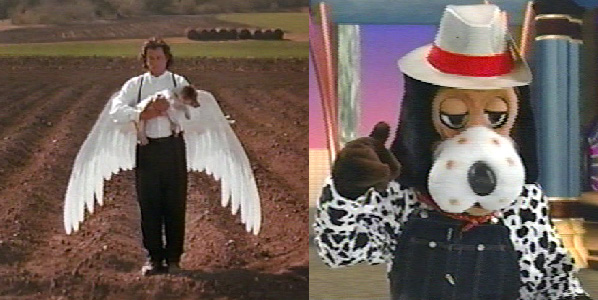
“What difference does it make if someone is terminal? We are all terminal.” 24
layla commented: 4-21-2008 9:01 PM “In 2007 Guillermo Vargas Habacuc a so called artist took an abandoned dog from the streets tied him to a very short rope to a wall in an art gallery and left a kettle of food on the other side of the room beyond his reach and left him there to slowly die of hunger and thirst. The socalled artist of such cruelty and the visitors of the gallery of art watched the agony of this animal. The dog finally died of famine surely after a painful absurd and incomprehensible torture. The prestigious Centralamerican Biennial of Art decided that this horrible act committed by this guy was art and Guillermo Vargas Habacuc has been invited to repeat his cruel actions in said Biennial in 2008. i seen this post on facebook and a few pictures of the poor innocent dog starving to death it broke my heart and i had to see if peta was aware of this sick man who thinks this i some great at creation.” 25
olivia commented: 5-10-2008 5:35 PM “i hate you. you should be put in the poor dog’s possision. you can’t imagine how many people hate you. almost more than a million. just so you know thats not art. the dog died because of you. you should go to prison because of this. you broke peoples’ hearts. i am really upset at you i could write all day long if i have to because you just waisted a life i wish i could waiste youres!!!!!! do you wish all the animals should die? you just made my day so so so horrible. im going to tell everyone what you just did. just so you know i’m cring. i hate hate hate hate you. you should be ashamed of your self. so listen to this just because you think your all that doesn’t mean that you can kill an other animal. i have 7 animals and you are not going to touch them! that dog did nothing to you. if heshe did doesn’t mean you should kill him! please don’t touch any other animal!!!!!! you suck!!!!!!!!!!!!!!!!!!!!!!!!!!!!!!!!!!!!!!!!!!!!!!!!!!!!!!!!!!!!!!!!!!!!!!!!!!!!!!!!!!!!!!!!!!!!!!!!!!!!!!!!!!!!!!!!!!!! P.s i hate youuuuuuuuuuuuuuuuuuuuu” 26
Renate commented: 5-5-2008 1:34 PM “Here’s a thought let’s tie up Guillermo Vargas at one of his own exhibits and starve him to death!” 27
Rainie M commented: 4-28-2008 2:59 PM “Oh Gods! How can anyone be so bloody heartless? Dead or dying animals are NOT art…things like this only come from sick minds. Is the human race devolving so much that we have come down to this as entertainment? If you want Art go to a Museum . Geez this is just sick…” 28
Tucker commented: 4-26-2008 10:43 AM “THIS IS DOWN RIGHT UNCALLED FOR DIGUSTINGCRUEL AND THESE PEOPLE NEED TO BE LOCKED UP AND CHARGED BIG TIME!!!!!!!!!!!!!!!!!!!!!!!!!!!!!!!!!!!!!!!!!!!!!!!!!!!!!!!!!! I AM CRYING SO HARD RIGHT NOW IT IS UNBELIEVABLE WHAT $IN PEOPLE DO TO ANIMALS AND THIS ALL NEEDS TO STOP NOW AND BIG TIME CHARGES AND JAIL TIME NEED TO BE STRONGER AND LONGER IN ALL STATES AND AROUND THE WORLD!!!!!!!!!!!!!!!!!!!!!!!!!!!!!!!!!!!!!!!!!!!!!!!!!!!!!!!!!!!!!!!!!!!!!!!!!!!!!!!!!!!!!!!!!!!!!!!!!!!!!!!!!!!!!!!!!!!!!!! SAVE THE ANIMALS!!!!!!!!!!!!!!!!!!!!!!!!!!!!!!!!!!!!!!!!!!!!!!!!!!!!!!!!!!!!!!!!!!!!!!!!!!!!!!!!!!!!!!!!!!!!!!!!!!!!!!!!!!!!!!!!!!!!!” 29
Angie commented: 4-24-2008 12:55 PM “I am so sickend by this whole so called art.. I am a artist myself. ! And i think someone need to tie this guy up and not feed him any food and have people watch him starve . Then he will realize how it feels. He gives a bad name to other artist out there!” 30
yf commented: 4-22-2008 2:32 PM “you know he really shoudl have starved himself and then do a ‘selfportrait’.. much more apt.. silly stupid man.. so pointless.. so banal.. people KNOW what skeletal skin and bones animals look like .. we have seen them.. we know what skeletal starved humans look like too infact.. we dont’ need a dumb dimwit 12 brained idiot to INTENIONALLY starve a dog in ORDER to produce his pointless ‘artwork’.. what a dumb stupid peabrained twit !” 31
Kristin Gleeson commented: 4-22-2008 1:29 AM “Yeah I’ve seen something like this before but what was it? Oh yeah the HOLOCAUST. Thousands of people collected subdued and starved to death. Was that an artistic masterpiece? If you call this art you’d have to call Hitler an artist I mean after all he was trying to make a culturally altering statement as well. It’s not art it’s sadistic immoral and completely disgusting. This poor creature did not deserve this and neither does any other animal on the planet.” 32
“Do not imitate a dog, but make your organism enter into composition with something else in such a way that the particles emitted from the aggregate thus composed will be a canine as a function of the relation of movement and rest, or of molecular proximity, into which they enter.” 33
“Its efficiency is striking. There is nothing extra, superfluous or obscure about Mr. Kulik’s performance. For all intents and purposes, he is a dog: he can be scary and unpredictable and territorial. After all, he’s in his prime, about 5 dog years old; visitors who wish to enter his cage may do so one at a time and must put on the quilted overalls and arm-guards that hang near the chained and barred door to his cage.” 34
“The choice of the term ‘pack’ for this older and more limited kind of crowd is intended to remind us that it owes its origin among men to the example of animals, the pack of animals hunting together. Wolves, which man knew well and from whom many of the dogs he uses derive, had impressed him very early. Their occurrence as mythical animals among so many peoples, the conception of the were-wolf, the stories of men who, disguised as wolves, assailed and dismembered other men, the legend of children brought up as wolvesall these things and many others prove how close the wolf was to man.” 35
“Saying it would be too confusing, a judge has denied the petition of a so-called ‘furry’ to legally change his name to Boomer the Dog. Forty-four-year-old Green Tree resident Gary Guy Mathews says he filed for the name change in June because he’s a fan of a short-lived 1980s NBC television series called “Here’s Boomer,” which featured a dog that rescued people.” 36
Where’s Waldo, #1.5 – Sun Aug 15, 2010 10:31 PM EDT “This boy ain’t wired right. I’ve heard of men wanting to be a women and women wanting to be men but this is a new one on me. Mom and Dad must have raised the poor kid in a kennel instead of a crib. Wonder what his favorite pup food was? Of course maybe he’s smarter than any of us thinks……or maybe not.” 37
dave-735909, Thu Aug 12, 2010 10:21 AM EDT “Why can’t we just respect people’s constitutional right to be crazy?” 38
Susi-Oh, Thu Aug 12, 2010 12:10 PM EDT “My sentiments exactly but how far do you want to take this? Should we just let him bark back when you ask him a question? Can you introduce a guy like that with a straight face? He’s big for a dog and might scare little children. Actually, even without the name change he looks a bit scary.” 39
Janet A., #15 – Thu Aug 12, 2010 10:59 AM EDT “If this idiot was truly a dog, we’d put him to sleep for being insane. Just a thought.” 40
wchall1949, #2 – Thu Aug 12, 2010 10:15 AM EDT “OMG – the really frightening thing here is that this guy is allowed to marry & reproduce!!! Truly scary!! What a moron!!!” 41
Sues-343312, #2.1 – Thu Aug 12, 2010 11:22 AM EDT “Well he is 44 yrs old has managed to not procreate up to now. Let’s just hope he meets up with a spayed female” 42
3:26 . A close-up of a crying child, with a dissolve of snow over his face. He says “Daddy…”
Close up of an adult man, he says “I don’t have a daddy.”
A girl wears a party hat. Lying on her bed, she talks to her brother, also wearing a party hat. She says “I just miss him so much…”
Cut to a different girl in pigtails addressing a bloodhound wearing a king’s crown and fur cape. She says “I miss him too.”
3:30 . Close-up of a crying boy. “I miss him, mom.”
Angry-looking farmer standing under a tree. He says “Your mother passed on.”
3:32 . A woman lays on a bed with a girl. “…to join the angels.”
A man looks up to the sky and gestures upwards “She’s in heaven.”
A woman with a party hat “watching over you right now.”
3:37 . A boy addresses a dog. “My dad used to do that.”
A boy and his mother talk as she drives. The boy says “He wants a dad.”
A woman sits next to a boy outside with a rocky hill behind them. He is looking through binoculars. She says “You remind me a lot of your dad sitting there.”
“When they’re your best friend it turns into this weird, gross, furry pile where you can’t tell where the lines are between human and dog, master and slave, and sex, and it’s just ugh.” 43
“Bestiality lowered a man to the level of a beast, but it also left something human in the animal.” 44
“A man has appeared before Limerick District Court charged with ordering his Alsatian dog to have sex with a 43-year-old mother of four, who died from an adverse allergic reaction to the intercourse.” 45
“Addressing the consent issue, Daniels writes, ‘[T]he truth is that animals, particularly domesticated ones, don’t consent to most of the things that happen to them.’ Animal sexual autonomy is regularly violated for human financial gain through procedures such as AI. Such procedures are probably more disturbing physically and psychologically than an act of zoophilia would be, yet the issue of consent on the part of the animal is never raised in the discussion of such procedures. Should the day Bentham speaks of arrive when animal rights are recognized by society and the law, an argument which speaks only to the zoophile’s right to fair exercise of his property rights in the animals he owns may prove an insufficient legal justification for acts of zoophilia.” 46
“In 1812 in a similar case in strongly Federalist Seneca County, New York,William Moulton, a fifty-eight-year-old veteran of the Revolutionary War and a prominent Democratic-Republican, was accused of buggering a bitch, which then delivered a litter of puppies that ‘had large heads, no hair on them nor tails, and on the side of their head they had small ears.'” 47
“I am for the majestic art of dog-turds, rising like cathedral.” 48
“The right of sovereignty was the right to take life or let live. And then this new right is established: the right to make live and to let die.” 49
“Though a single gull had already struck Melanie on the forehead the day before, the choice of the children’s party for this first fully choreographed attack suggests the extent to which the birds take aim at the social structures of meaning that observances like the birthday party serve to secure and enact: take aim, that is, not only at children and the sacralization of childhood, but also at the very organization of meaning around structures of subjectivity that celebrate, along with the day of one’s birth, the ideology of reproductive necessity.” 50
“Death is outside the power relationship. Death is beyond the reach of power, and power has a grip on it only in general, overall or statistical terms…death now becomes, in contrast, the moment when the individual escapes all power, falls back on himself and retreats, so to speak, into his own privacy. Power no longer recognizes death. Power literally ignores death.” 51
“Physician assisted suicide is fundamentally inconsistent with the physician’s professional role.” 52
“Even worse their comments continue to make no distinction between hierarchical and non-hierarchical organizations and institutions — simply rejecting all organization — which is tantamount, if you think about it for a minute, to proposing a future that lacks workplaces, religious centers, families, any kind of assemblies, and so on — a future in which lone individuals or small groups fend for themselves (a vision seemingly not too far from what they propose).” 53
‘It is critical that the medical profession redoubles its efforts to ensure that dying patients are provided optimal treatment for their pain and other discomfort. The use of more aggressive comfort care measures, including greater reliance on hospice care, can alleviate the physical and emotional suffering that dying patients experience. Evaluation and treatment by a health professional with expertise in the psychiatric aspects of terminal illness can often alleviate the suffering that leads a patient to desire assisted suicide.” 54
“Their vision of a commune offers very little guarantee of its own basic existence. There are no proposed methods for deciding what will be produced or consumed nor how much of each or its distribution in a socially responsible way.” 55
“The euthanasia of animals has been acknowledged by most animal protection organizations, including [The Humane Society of the United States], as an appropriate and humane means of ending the suffering of an animal in physical distress. It is also used widely to end the lives of animals who have severe behavioral problems, including aggression, and cannot be adopted into an appropriate new home because they pose a threat to the health and safety of people or other animals.” 56
“Once we know where it is we want to go, we can then act with the urgency needed to organize and build institutions and movements able to win change and create the necessary foundations for a future society.” 57
“Those who demand another society should better start to realize that there is none left. And maybe they would then stop being wannabe-managers.” 58
“This is the dog’s real trick, the height of animal acting. Not surprisingly, the imitated action is one of violence and must have been somewhat complicated; because all pet dogs, and dog performers most of all, must be nonviolent and cooperative, the animal actor here must go against its ‘nature’ in order to successfully set up the final tableau. That animals can be domesticatedmade to forego violence in order to serve peopleis the triumph of human culture over nature. That they can then be trained to appear violentto attack humansis the ironic confirmation of this subjection.” 59
“Should you battle on, take the pain, endure the indignity, and await the inevitable end, which may be days, weeks or months away? Or should you take control of the situation and resort to some form of euthanasia, which in its modern-language definition has come to mean ‘help with a good death’?” 60
“At the final stage of this evolution, we see the first socialist mayor of Paris putting the finishing touches on urban pacification with a new police protocol for a poor neighborhood, announced with the following carefully chosen words: ‘We’re building a civilized space here.’ There’s nothing more to say, everything has to be destroyed.” 61
3:43 A montage of eerily smiling children’s’ faces. Audio is the word “dad” played over and over as it overlaps and becomes “dog”. The words dad and dog are repeated in a loop. The video becomes a distorted montage of psychedelic faces of children and dogs. Eventually the words dad and dog becomes god.
4:03 The montage audio and video end abruptly.
A small dog says “I know something we can do.”
A shot of a Bernese, who says “Poop” then winks.

DoggieWoggiez! PoochieWoochiez! $20
http://www.everythingisterrible.bigcartel.com/product/doggiewoggiez-poochiewoochiez
http://www.everythingisterrible.com/
Featured image: Remixthebook Cover
“For us, art is not an end in itself … but it is an
opportunity for the true perception and criticism
of the times we live in.” Hugo Ball.
The challenge in trying to review a book like Mark Amerika’s Remixthebook, is the feeling you can only do justice to the text by doing the same with your review. The apparent simplicity coupled with the multifarious outcomes are intoxicating. You could be mistaken for believing that every possible remix would produce fresh and exciting outcomes. The key of course, is to have good source material in the first place. Also, to have developed a keen eye for what blends and meshes together and what doesn’t. Even the most disparate work requires judgment and prior awareness. Remixthebook asks us to consider the idea of remixology as part of the work of modern artists. The tone and style of the book is a blend of ideas, voices and thoughts with a myriad of concepts, which attempts be the very embodiment of the ideas it espouses.
Amerika explores various precedents for the remixological concept and draws on some known practitioners from the past: amongst them, Allen Ginsberg, William S. Burroughs and Brion Gysin. He explores existing ideas and welds them into his own armoury. Their ideas considered as part of his own creative practice, brought back to the now with new life, in our contemporary networked culture.
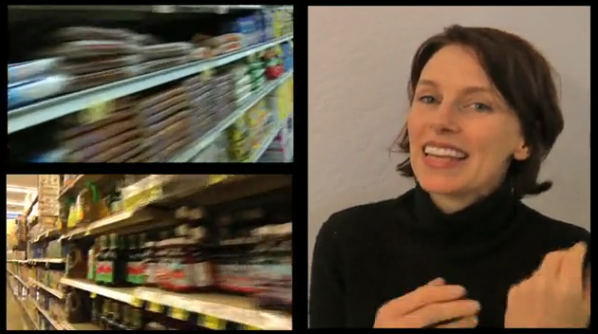
Other than just being a systematic breakdown of the different types of remixing and their potential outputs (or artifacts, as they might be better known in an art critical framework?) Amerika considers the pathways and theoretical underpinnings of remix culture. Having taken this beyond his own practice of the written word and web-based projects, he considers his recent and ongoing VJ work. Blending and collage-making with images during live music performances suggests some of the instinctive, instantaneous ideas that come out of a lifetime’s collecting, collating and absorbing of diverse imagery, words and cultural concepts. It’s within this process that he believes more novel outcomes can arise, against the constant flux of media creation and dissemination. It is the ‘becoming’ of the media artist that is revealed in the live remixing performance.
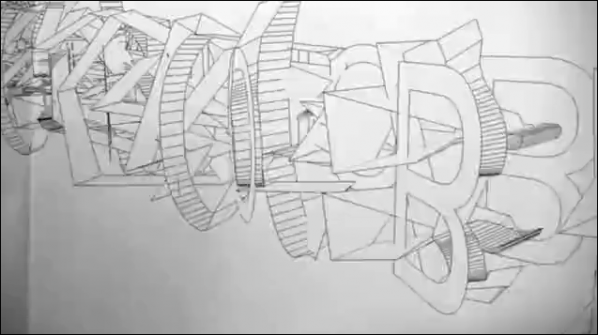
Reflecting on this process of cultural assimilation Mark Amerika, situates remixology within a wider creative output and theoretical framework. This involves a cross hybrid of everyday, mainstream references with high art and ‘high’ theory, all written in his at once complex and convoluted, yet easily read and enjoyable writing style. But like remixology, what looks simple is the result of deep reading and heavy conceptual thinking. This isn’t to say that you won’t have trouble decoding the writing and getting to the heart of his thinking, but it helps if you spend time with the text and allow the rhythms and structures to become second nature to you. Close reading allows the text to fall into place. For example, consider the following extract from the section eros intensification:
Here is where we enter the realm of
what I have been calling intersubjective jamming
which is different than the idea of a Networked Author
or Collaborative Groupthink Mentality that preys
on the lifestyles of the Source Material Rich
and seemingly forever Almost Famous.
It is worth remembering that Mark Amerika is a creative writer first and foremost. He uses theory as a palette from which to draw out ideas and situations for further reflection and to help give some context to the point he is trying to make. The text of remixthebook is an example of his creative practice in action, as much as it is a personal reflection on his attempts to develop a thought process for it. Theory becomes entwined in critical reflection and creative output. You don’t necessarily come to remixthebook for philosophical answers and hard academic points of view, instead you ride the maelstrom of thoughts and conceptualizing to gain a better handle on a way of considering artistic practice.
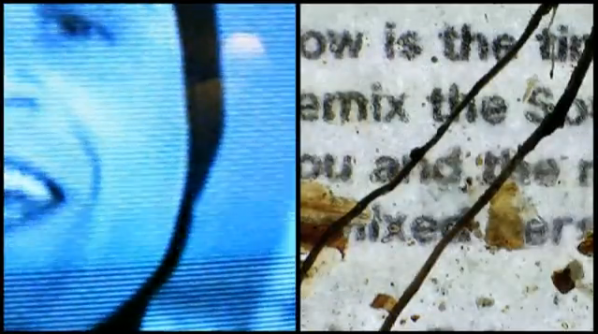
The website of the book (probably a ubiquitous extra for any media art-related publication these days) follows a natural path of inclusion and invites artists to take sections of the book and remix them according to their own aesthetic and remixological preferences. While some of the work brings in extra visuals and places itself in a flowing context of media streams, allowing different work to become part of the project, Rick Silva’s The Isarithm sources Amerika’s Sentences on Remixology 1.0 and explodes them out of the screen and into a layered and playful vortex of shapes and lines.
Will Leurs uses some captured footage taken directly off the tv screen for A Pixel and Glitch Hotel Room and combines it with some source material supplied by Amerika from several ‘lectures’ he has supplied. These lectures appear within several other contributors work as well. The point of some of these remixes and the varied forms they take (the collection includes some purely audio work) is that, as well as being interesting works themselves, they are exemplars and guides to even further potentials of the remixological principle.
Mark Amerika’s Remixthebook at times may leave you looking beyond it to the appendix or for any footnotes that would fill out spaces or help make conceptual leaps for you. That isn’t the point of the book. The idea is to take the book as a starting point and expand on your own creative process. Possibly the best approach is to literally cut-up the book and try some experimentation of your own, Brion Gysin style. Flex the covers back and pull out the pages. Through destruction and reconfiguration, the book might be bent to your will and become something that you can use. Perhaps the sight of a ripped and destroyed book would strike horror into some authors. I can’t help thinking that Mark Amerika would take great joy in the image and say that he’d planned it all along.
The remixthebook.com website
http://www.remixthebook.com
The remixthebook Blog
http://www.remixthebook.com/theblog
Remixology by OpenMedia.ca – a national, non-partisan, non-profit organization working to advance and support an open and innovative communications system in Canada.
http://openmedia.ca/remixology
Society of the Spectale (A Digital Remix)
By Mark Amerika On August 16, 2011.
http://www.remixthebook.com/society-of-the-spectale-a-digital-remix
REMIXTAPE 2.0 //
Remixology is a music blog based in Paris (France) devoted to remixes friendly music.
http://remixology.tumblr.com/
REFF- Remix the world! Reinvent reality! exhibition at Furtherfield Gallery between 25 February and 26 March 2011. http://www.furtherfield.org/exhibitions/reff-remix-world-reinvent-reality
Visitorsstudio – an online place for real-time, multi-user mixing, remixing, collaborative creation, many to many dialogue and networked performance and play.
http://www.visitorsstudio.org/x.html
Brion Gysin. Essays & Stories, Interviews, Excerpts & Publications
http://briongysin.com